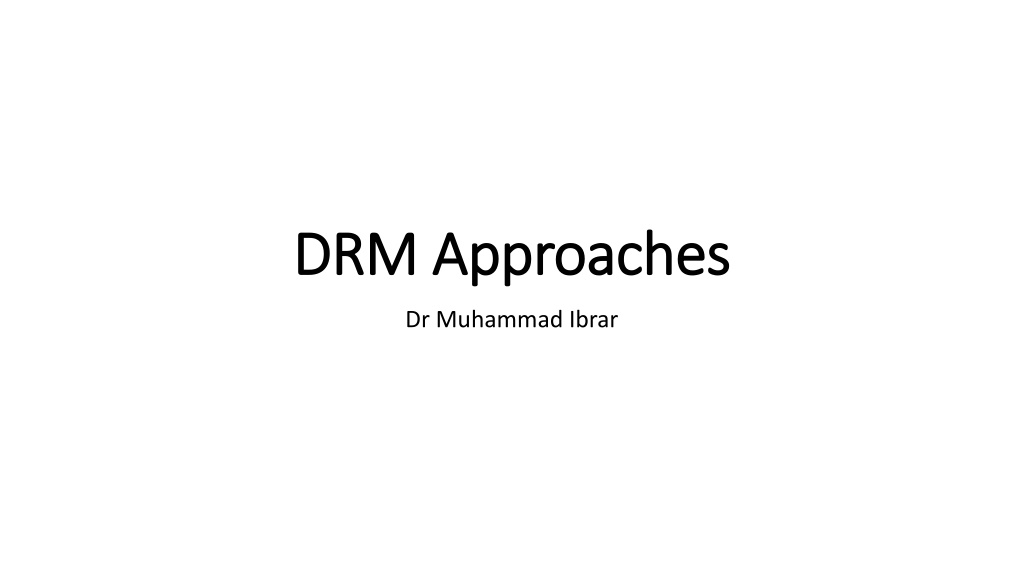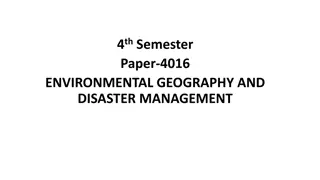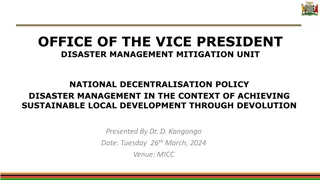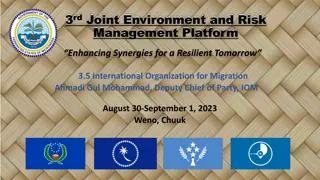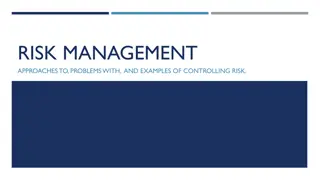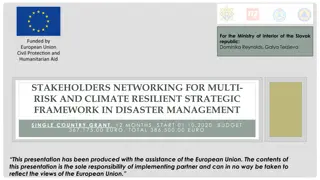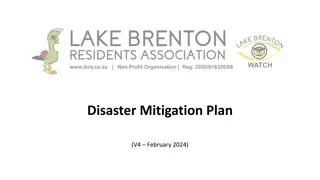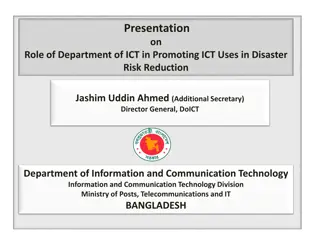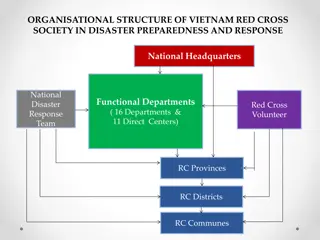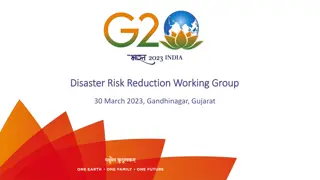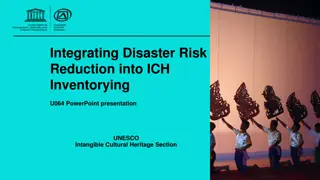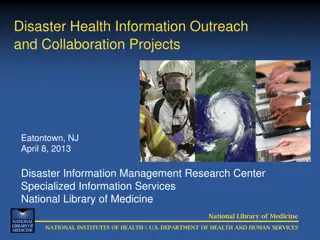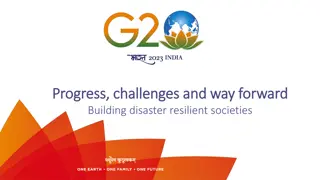Disaster Risk Reduction (DRR) Approaches and Strategies
Disaster Risk Reduction (DRR) involves taking actions to analyze and manage the causes of disasters, reduce vulnerability, and improve preparedness. It includes steps to ensure DRR is a priority, identify risks, build resilience, reduce underlying factors, and enhance preparedness. Components of DRR include mitigation, preparedness, response, and recovery, with a focus on reducing the impact of disasters and enhancing safety. Mitigation efforts aim to lessen the impact of disasters by reducing risks through sustained actions. Various approaches such as risk identification play a key role in disaster mitigation strategies.
Uploaded on Mar 02, 2025 | 0 Views
Download Presentation

Please find below an Image/Link to download the presentation.
The content on the website is provided AS IS for your information and personal use only. It may not be sold, licensed, or shared on other websites without obtaining consent from the author.If you encounter any issues during the download, it is possible that the publisher has removed the file from their server.
You are allowed to download the files provided on this website for personal or commercial use, subject to the condition that they are used lawfully. All files are the property of their respective owners.
The content on the website is provided AS IS for your information and personal use only. It may not be sold, licensed, or shared on other websites without obtaining consent from the author.
E N D
Presentation Transcript
DRM Approaches DRM Approaches Dr Muhammad Ibrar
What is Disaster Risk Reduction (DRR)? Disaster Risk Reduction is: Actions taken to reduce the risk of disasters and the adverse impacts of natural hazards, through systematic efforts to analyze and manage the causes of disasters, including through avoidance of hazards, reduced social and economic vulnerability to hazards, and improved preparedness for adverse events - UN International Strategy for Disaster Reduction (ISDR) The conceptual framework of possibilities to minimize vulnerabilities and disaster risks throughout a society, to avoid (prevention) or to limit (mitigation and preparedness) the adverse impacts of hazards, within the broad context of sustainable development. - United Nations Office for Disaster Risk Reduction elements considered with the
Steps for Implementing DRR Strategy 1. Ensure that DRR is a national and local priority with strong institutional basis for implementation. 2. Identify, assess, and monitor disaster risks and enhance early warning. 3. Use knowledge, innovation, and education to build a culture of safety and resilience at all levels. 4. Reduce the underlying risk factors. 5. Strengthen disaster preparedness for effective at all levels.
Components of Disaster Risk Reduction 1. Mitigation - Measures to be taken before and after an event 2. Preparedness - Measures to be taken before and after an event 3. Response - Measures to be taken during and immediately after an event 4. Recovery - Post disaster measures
1. Mitigation What is Mitigation? Mitigation is the effort to reduce loss of life and property by lessening the impact of disasters. It is permanent reduction of the risk of a disaster. Mitigation lessens the likelihood and severity of disaster by implementing sustained actions, such as improved construction practice, to reduce or eliminate long-term risk to people and property. Mitigation of hazard impacts reduces the possibility of disaster and reduces the need for assistance. Mitigation includes recognizing that disasters will occur; attempts are made to reduce the harmful effects of a disaster, and to limit their impact on human suffering and economic assets. Types of Mitigation 1. Primary Mitigation: Primary mitigation refers to increasing the resistance to the hazard and reducing vulnerability. 2. Secondary Mitigation: Secondary mitigation refers to reducing the effects of the hazard (preparedness).
Various Approaches / Strategies of Disaster Mitigation 1) Risk Identification The first step in disaster mitigation is to identify areas that are at risk to hazard. Once the priority zones have been identified, comprehensive and integrated risk reduction programs should be initiated. 2) Land-Use Planning Land-use planning includes the mapping of disaster prone area which should contain number of livestock per unit area, crop density, population density, road network, location of shelter etc. 3) Structural and Non-Structural Mitigation measures may involve construction (e.g. dykes and flood protection walls, and also ecosystem-based approaches to flood and erosion control, such as planting mangrove forests) and non-material measures (e.g. land-use restrictions in flood risk areas). 4) Disaster relief and Rehabilitation Supply emergency humanitarian aid to victims for survival and relocate the peoples whose residence have been destroyed very badly, inappropriate for living.
Contd. 5) Disaster Management Training and Education Trained up group of personnel need to be formed in local, national and regional context to mitigate and reduce disaster risk and damages. 6) Role of Media in Disaster Risk Reduction Media is the effective means to circulate the news and bulletins about hazard warning and mitigation processes. 7) Institutional Capacity Building Several institutional bodies are engaged with disaster mitigation processes such as local community, organization, local and national government, NGOs, international organization etc. Ability and capacity of those institutions should be as high as they are capable to mitigate the disaster.
2. Disaster Preparedness Preparedness refers the measures that ensure the organized mobilization of personnel, funds, equipment, and supplies within a safe environment for effective relief. Preparedness lessens the severity of disasters by preparing people for disaster, developing plans to ensure an effective response and recovery and training people to implement plans after a disaster occurs. Preparedness Includes: 1) Forecasting and Warning for Different Hazards. 2) Emergency Preparedness - Organized personnel for monitoring, alert and evacuation - Medical team - Search and rescue team -Availability of food reserve - Emergency monetary fund and seed reserve - Distribution of disaster supplies and equipment 3) Education, Training and Public Awareness
Weather Forecast and Early Warning Forecast Weather forecasting is the application of science and technology to predict the state of the atmosphere for a given location. Weather forecasts are made by collecting quantitative data about the current state of the atmosphere at a given place and using scientific understanding of atmospheric processes to project how the atmosphere will change. Tools: Various types of tools like Barometer, Radiosonde, Satellite (Geostationary and Polar Orbit), Radar, and other Equipment. Early Warning System Early warning is a major element of disaster risk reduction. It prevents loss of life and reduces the economic and material impact of disasters. early warning systems can be used to detect a wide range of events, such as vehicular collisions, missile launches, disease outbreaks, and so forth. To be effective, early warning systems need to actively involve the communities at risk, facilitate public education and awareness of risks, effectively disseminate alerts, and warnings and ensure there is constant state of preparedness.
Contd. Tasks Related to Early Warning 1) Communication 2) Indigenous Knowledge 3) Media 4) Instruction Types of Early Weather and Forecasting: Based on Duration 1) Short Range: 48 72 Hours (e.g. Cyclone, Hurricane, Bombing, Flood etc.) 2) Medium Range: 3 Days to 3 Weeks (e.g. Cold and Heat Wave, Floods etc.) 3) Long Range: Over a Season (El-Nino, La-Nino etc.) Types of Early Weather and Forecasting: Based on Purposes 1) Aviation 2) Shipping 3) Local 4) Agricultural Base
Level of Preparedness 1) Family 2) Community - Volunteering activities - Protesting environmental degradation -Awareness building - Emergency steps 3) National: Developing principles and laws, executing rules, funding etc. 4) International / Regional: Seminar, Conference, Exchange of Technology and knowledge.
3. Response Disaster response is the implementing phase of the disaster preparedness step. The focus in the response phase is on meeting the basic needs of the people until more permanent and sustainable solutions can be found. To be ready for response with capability to provide rapid and efficient medical, rescue and emergency supplies, and equipment to those in need, following steps of task should be implemented: 1. Mobilization 2. Assessment 3. Requirement/Analysis 4. Rescue and Evacuation 5. Emergency Assistance (e.g. medical care, shelter, distribution of food, water and supplies)
4. Recovery Disaster recovery (DR) involves a set of policies and procedures to enable the recovery or continuation of vital technology infrastructure and systems following a natural or human induced disaster. In other words, recovery is implementation of actions to promote sustainable redevelopment following a disaster, including new building code standards and land-use planning controls. Recovery consists of: 1. Rehabilitation 2. Reconstruction (During reconstruction it is absolutely necessary to consider mitigation measures including relocation, land use zoning etc.) - Rebuilding of house and public buildings - Financing for rebuilding - Repair of roads, bridge, water system etc. 3. Psychological counseling 4. Long-term assistance to rebuild the community.
